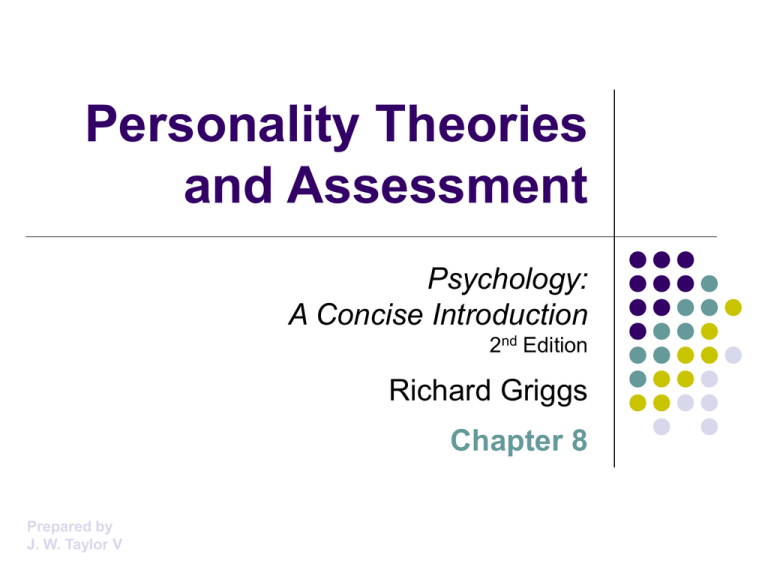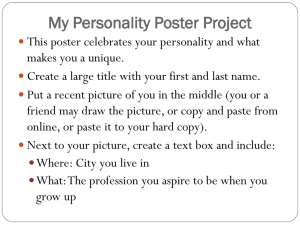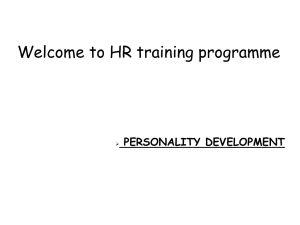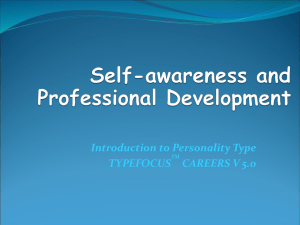
Personality Theories
and Assessment
Psychology:
A Concise Introduction
2nd Edition
Richard Griggs
Chapter 8
Prepared by
J. W. Taylor V
Personality
A person’s internally based
characteristic ways of
acting and thinking
The Journey…
The Psychoanalytic Approach to
Personality
The Humanistic Approach and the
Social-Cognitive Approach to
Personality
Trait Theories of Personality and
Personality Assessment
The Psychoanalytic
Approach to Personality
Freudian Classical Psychoanalytic
Theory of Personality
Neo-Freudian Theories
of Personality
Freudian Classical Psychoanalytic
Theory of Personality
Developed by Sigmund Freud in the late
nineteenth century and continued until
his death in 1939
Freud received a medical degree and
established a practice as a clinical neurologist
treating patients with emotional disorders
Believed sex was a primary cause of
emotional problems and was a critical
component of his personality theory
Remains an important influence in
Western culture
Freud’s Three Levels of Awareness
1. The conscious mind is what you are presently aware of,
what you are thinking about right now
2. The preconscious mind is stored in your memory that you
are not presently aware of but can gain access to
3. The unconscious mind is the part of our mind of which we
cannot become aware
It contains, however, the primary motivations for all of our
actions and feelings – our biological instinctual
drives (such as for food and sex)
and repressed unacceptable
thoughts, memories, and
feelings, especially
unresolved conflicts
from our early
childhood experiences
Freud’s
Three-Part Personality Structure
Id
Ego
Superego
The Id
Is the original personality, the only part present at
birth and the part out of which the other two parts of
our personality emerge
Resides in the unconscious mind
Includes our biological instinctual drives, the primitive
parts of our personality located in our unconscious
Life instincts for survival, reproduction, and pleasure
Death instincts, destructive and aggressive drives
detrimental to survival
Operates on a pleasure principle; that is, it demands
immediate gratification for these drives without the
concern for the consequences of this gratification
The Ego
Starts developing during the first year or so of life
to find realistic and socially-acceptable outlets for
the id’s needs
Operates on the reality principle, finding gratification
for instinctual drives within the constraints of reality
(the norms and laws of society)
Part of the ego is unconscious (tied to the id) and part
of the ego is conscious and preconscious (tied to the
external world)
Serves as the executive manager of the personality
The Superego
Represents one’s conscience and idealized
standards of behavior in their culture
Operates on a morality principle, threatening to
overwhelm us with guilt and shame
The demands of the superego and the id will come into
conflict and the ego will have to resolve this turmoil
within the constraints of reality
To prevent being overcome with anxiety because of
trying to satisfy the id and superego demands, the ego
uses what Freud called defense mechanisms,
processes that distort reality and protect us from anxiety
Freud’s Defense Mechanisms
Repression
Regression
Displacement
Unknowingly placing an
Not remembering a
unpleasant memory or
traumatic incident in
thought in the unconscious which you witnessed a
crime
Reverting back to
Throwing temper tantrums
immature behavior from an as an adult when you
earlier stage of
don’t get your way
development
Redirecting unacceptable
Taking your anger toward
feelings from the original
your boss out on your
source to a safer substitute spouse or children by
target
yelling at them and not
your boss
Freud’s Defense Mechanisms
Sublimation
Replacing socially
unacceptable impulses
with socially acceptable
behavior
Channeling aggressive
drives into playing football
or inappropriate sexual
desires into art
Reaction
Formation
Acting in exactly the
opposite way to one’s
unacceptable impulses
Being overprotective of
and lavishing attention on
an unwanted child
Projection
Attributing one’s own
unacceptable feelings and
thoughts to others and not
yourself
Accusing your boyfriend
of cheating on you
because you have felt like
cheating on him
Rationalization Creating false excuses for
one’s unacceptable
feelings, thoughts, or
behavior
Justifying cheating on an
exam by saying that
everyone else cheats
Unhealthy Personalities
Develop not only when we become too
dependent upon defense mechanisms, but
also when the id or superego is unusually
strong or the ego unusually weak
Freud’s
Psychosexual Stage Theory
Was developed chiefly from his own childhood memories
and from his years of interactions with his patients and their
case studies that included their childhood memories
An erogenous zone is the area of the body where the id’s
pleasure-seeking psychic energy is focused during a
particular stage of psychosexual development
A change in erogenous zones designates the beginning
of a new stage
Fixation occurs when a portion of the id’s pleasure-seeking
energy remains in a stage because of excessive
gratification or frustration of our instinctual needs and
continue throughout the person’s life and impact their
behavior and personality traits
Five Psychosexual Stages
Oral Stage (birth to 18 months)
Anal Stage (18 months to 3 years)
Phallic Stage (3 to 6 years)
Latency Stage (6 years to puberty)
Genital Stage (puberty to adulthood)
Freud’s Psychosocial States
of Personality Development
Stage (age range)
Erogenous Zone Activity Focus
Oral
(birth to 1½ years)
Mouth, lips, and
tongue
Sucking, biting, and
chewing
Anal
(1½ to 3 years)
Anus
Bowel retention and
elimination
Phallic
(3 to 6 years)
Genitals
Identifying with same-sex
parent to learn gender role
and sense of morality
Latency
(6 years to puberty)
No erogenous
zone
Cognitive and social
development
Genital
(puberty to
adulthood)
Genitals
Development of sexual
relationships, moving
toward intimate adult
relationships
Potty Training
Parents try to get the child to have self-control
during toilet training
If the child reacts to harsh toilet training by trying to get
even with the parents by withholding bowel movements, an
anal-retentive personality with the traits
of orderliness, neatness, stinginess,
and obstinacy develops
The anal-expulsive personality
develops when the child rebels
against the harsh training and
has bowel movements
whenever and wherever
he desires
Phallic Stage Conflicts
In the Oedipus conflict, the little boy
becomes sexually attracted to his
mother and fears the father (his rival)
will find out and castrate him
In the Electra conflict, the little girl is
attracted to her father because he
has a penis; she wants one and feels
inferior without one (penis envy)
Identification
In the process of identification, the child adopts
the characteristics of the same-sexed parents and
learns their gender role (the set of behaviors
expected of someone of a particular sex)
It is during identification that the superego begins
to develop
Evaluation of Freud’s
Psychoanalytic Theory of Personality
Freud’s notion of an “unconscious” level of
awareness is not accessible to anyone and is
impossible to examine scientifically
Indeed, unconscious information processing does
impact our thinking and behavior
However, the unconscious is not a storehouse of
instinctual drives, conflicts, and repressed memories
and desires
Although early childhood experiences are
indeed important, there is little evidence for his
psychosexual stages impacting development
Evaluation of Freud’s
Psychoanalytic Theory of Personality
Contemporary researchers think repression,
seldom, if ever, really occurs
We understand today how Freud’s questioning
during therapy may have created such
“repressed’ memories in his patients
There is evidence we fight hard to maintain
self-esteem, but not necessarily through
defense mechanisms as Freud described
them
Neo-Freudian
Theories of Personality
Agree with many of Freud’s basic ideas,
but differ in one or more important ways
Carl Jung’s
Collective
Unconscious
Alfred Adler’s
Striving for
Superiority
Karen Horney
and the
Need for
Security
Carl Jung’s
Collective Unconscious
The collective unconscious
is the accumulated universal experiences
of humankind, with each of us inheriting
the same cumulative storehouse of all
human experiences
These experiences are manifested in
archetypes, which are images and
symbols of all the important themes in the
history of humankind (e.g., God, mother,
hero)
Notions of collective unconscious and
archetypes are more mystical than
scientific and cannot be empirically tested
Carl Jung’s
Collective Unconscious
Jung proposed two main personality attitudes,
extraversion and introversion
Jung also proposed four functions/styles of
gathering information
Sensing is the reality function in which the world is
carefully perceived
Intuiting is more subjective perception
Thinking is logical deduction
Feeling is the subjective emotional function
The two personality attitudes and four functions
are the basis for the Myers-Briggs Type
Indicator, still in wide use today
Alfred Adler’s
Striving for Superiority
Adler thought the main motivation was what he
termed “striving for superiority” – to overcome
the sense of inferiority that we feel as infants
given our totally helpless and dependent state
A healthy person learns to cope with these
feelings, becomes competent, and develops a
sense of self-esteem
Inferiority complex is the strong feeling of
inferiority felt by those who never overcome
this initial feeling of inferiority
Karen Horney and
The Need for Security
Focused on dealing with our need for security, rather
than a sense of inferiority
A child’s caregivers must provide a sense of security
for a healthy personality to develop or else basic
anxiety, a feeling of helplessness and insecurity in a
hostile world, will result
Three neurotic personality patterns
Moving toward people
A compliant, submissive person
Moving against people
An aggressive, domineering person
Moving away from people
A detached, aloof person
The Humanistic Approach
and the Social-Cognitive
Approach to Personality
The Humanistic Approach
to Personality
The Social-Cognitive Approach
to Personality
Alternative Approaches
Humanistic theories developed in the 1960s as a part
of a response to the deterministic psychoanalytic and
strict behavioral psychological approaches that then
dominated psychology and the study of personality
The humanistic approach emphasizes conscious free will
in one’s actions, the uniqueness of the individual person,
and personal growth
During the 1960s, social-cognitive theorists rebelled
against the narrowness of the strict behavioral
approach to the development of personality,
emphasizing both social and cognitive factors along
with conditioning to explain personality development
The Humanistic
Approach to Personality
Abraham Maslow is considered the father of
the humanistic movement
He studied the lives of very healthy and creative
people to develop his theory of personality
Maslow’s hierarchy of needs is an
arrangement of the innate needs that motivate
our behavior, from the strongest needs at the
bottom of the pyramid to the weakness needs
at the top of the pyramid
Maslow’s Hierarchy of Needs
Self-Actualization
SelfEsteem
Social
Safety
Physiological
Maslow’s Hierarchy of Needs
Self-Actualization
Characteristics of self-actualized people include
Accepting themselves, others, and the nature of world for
what they are
Having a need for privacy
and only a few close,
emotional relationships
Being autonomous and
independent, democratic,
and very creative
Having peak experiences,
which are experiences of deep
insight in which you experience
whatever you are doing as fully as possible
Critique
Maslow hierarchy of needs is criticized for
being based on non-empirical vague
studies of a small number of people that he
subjectively selected as self-actualized
Roger’s Self Theory
Carl Rogers was a client-centered therapist
who dealt with young, bright college
students with adjustment problems
Emphasized self-actualization
Believe that people have a strong need for
positive regard – to be accepted by and have
the affection of others, especially the significant
others in our life
Roger’s Self Theory
Our parents set up conditions of worth, the
behaviors and attitudes for which they would give
us positive regard
Unconditional positive regard – acceptance and
approval without conditions
Meeting conditions of worth continues throughout life, and
a person develops a self-concept of what others think he
should be
Empathy from others, and having others be genuine with
respect to their own feelings is necessary if we are to selfactualized
Note that neither Maslow nor Roger’s theories are
research-based
The Social-Cognitive Approach
to Personality
Is research-based by combining
elements of three major research perspectives
Cognitive
Behavioral
Sociocultural
Maintains that learning through environmental
conditioning contributes to personality
development
However, social learning/modeling and cognitive
processes, such as perception and thinking, are also
involved and are actually more important to the
development of our personality
Bandura’s Self-System
The self-system is the set of cognitive processes by
which a person observes, evaluates, and regulates
his/her social behavior
There is a conscious decision to choose what behavior to
engage in, acting in accordance with the assessment of
whether the behavior will be reinforced or not
Self-efficacy is a judgment of one’s effectiveness in
dealing with particular situations and plays a major role in
determining our behavior
Low self-efficacy is associated with depression, anxiety, and
helplessness
High self-efficacy is associated with self-confidence, positive
outlook, and minimal self-doubt
Rotter’s Locus of Control
Locus of control is a person’s perception
of the extent to which he/she controls what
happens to him/her
External locus of control refers to the
perception that chance or external forces
beyond your control determine your fate
Internal locus of control refers to the
perception that you control your own fate
Locus of Control
People with an internal locus of control perceive
their success as dependent upon their own needs,
but they may or may not feel that they have the
competence (efficacy) to bring about successful
outcomes in various situations
People with an internal locus of control are
psychologically and physically better off
External locus of control may contribute to
learned helplessness, a sense of hopelessness
in which one thinks that he/she is unable to
prevent unpleasant events
Self-Perception
Attribution is the process by which we
explain our own behavior and that of others
Internal attribution means that the outcome is
attributed to the person
External attribution means that the outcome is
attributed to factors outside the person
Self-Perception
Self-serving bias is the tendency to make
attributions so that one can perceive
oneself favorably
If the outcome is positive, we make an internal
attribution for it
If the outcome is negative, we make an external
attribution for it
Self-serving bias is adaptive because it protects
us from falling prey to learned helplessness and
depression
Learned Helplessness
and Depression
Can result from:
Internal attributions for negative outcomes
(“I failed the test because I am no good at math”)
External attributions for positive outcomes
(“I aced the test because it was so easy”)
Pessimistic explanations are also stable
(i.e., the causes are permanent, “I will always
have no ability for math”) and global
(“I have no ability for anything”)
Trait Theories of Personality
and Personality Assessment
Trait Theories of Personality
Personality Assessment
Trait Theories of Personality
Personality traits are internally based, relatively
stable characteristics that define an individual’s
personality
Each trait is a dimension, a continuum ranging from one
extreme of the dimension to the other
Trait theorists use factor analysis and other
statistical techniques to tell them how many basic
personality factors (or traits) are needed to describe
human personality, as well as what these factors are
Factor analysis identifies clusters of test items (e.g., on a
personality test) that measure the same factor/trait
The Number and Kind
of Personality Traits
Raymond B. Cattell, using factor analysis,
found that 16 traits were necessary to
describe human personality
Hans Eysenck, also using factor analysis,
argued for three trait dimensions
Cattell and Eysenck differed because the
number of traits depends on the level of
categorization in the factor analysis
Eysenck’s theory is at a more general and
inclusive level of abstraction than Cattell’s
Eysenck’s Three-Factor Theory
ExtraversionIntroversion
NeuroticismEmotional
stability
PsychoticismImpulse
control
Eysenck argued that these traits are determined by heredity
Eysenck’s Three-Factor Theory
The biological basis for the extraversionintroversion trait is level of cortical arousal
(neuronal activity)
Introverts have higher normal-levels of arousal
than an extravert, so extraverts need to seek
out external stimulation to raise the level of
arousal in the brain to a more optimal level
Eysenck’s Three-Factor Theory
People who are high on the neuroticismemotional stability dimension tend to be overly
anxious, emotionally unstable, and easily upset
because of a more reactive sympathetic nervous
system
The psychoticism-impulse control trait is
concerned with aggressiveness, impulsiveness,
and empathy
A high level of testosterone and a low level of MAO, a
neurotransmitter inhibitor, lead to high levels of
psychoticism
Five-Factor Model of Personality
These five factors appear to be universal
and are consistent from about age 30 to
late adulthood
These factors are measured using an
assessment instrument called the NEO-PI
The Big Five Personality
Trait Dimensions
Dimension
High End
Low End
Openness
Independent, imaginative,
broad interests, receptive
to new ideas
Conforming, practical,
narrow interests, closed to
new ideas
Conscientiousness
Well-organized,
dependable, careful,
disciplined
Disorganized,
undependable, careless,
impulsive
Extraversion
Sociable, talkative,
friendly, adventurous
Reclusive, quiet, aloof,
cautious
Agreeableness
Sympathetic, polite, goodnatured, soft-hearted
Tough-minded, rude,
irritable, ruthless
Neuroticism
Emotional, insecure,
nervous, self-pitying
Calm, secure, relaxed, selfsatisfied
Personality Assessment
The main uses of personality tests are to aid
in diagnosing people with problems,
counseling, and making personnel decisions
Personality
Inventories
Projective
Tests
Personality Inventories
Are designed to measure multiple traits of
personality, and in some cases, disorders
Are a series of questions or statements for which
the test taker must indicate whether they apply to
him or not
The MMPI (the Minnesota Multiphasic
Personality Inventory) is the most widely used,
translated into more than 100 languages
MMPI
Uses a “True/False/Cannot Say” format with 567
simple statements (e.g., “I like to cook”)
Developed to be a measure of abnormal
personality, with 10 clinical scales such as
depression and schizophrenia
Items were developed and tested to differentiate
different groups of people (a representative sample
of people suffering a specific disorder versus a
group of normal people) on certain dimensions; to
be retained, the two groups generally responded to
an item in opposite ways
MMPI
Contains three validity scales, which
attempt to detect test takers who are
trying to cover up problems and fake
profiles or who were careless in their
responding
Its test construction method leads to
good predictive validity for its clinical
scales and its objective scoring
procedure leads to reliability in
interpretation
Projective Tests
Contain a series of ambiguous stimuli, such
as inkblots, to which the test taker
must respond about his
perceptions of the stimuli
Sample tests
Rorschach Inkblots Test
Thematic Apperception
Tests (TAT)
Rorschach Inkblots Test
Contains 10 symmetric inkblots used in
the test, in which the examiner then goes
through the cards and asks the test taker
to clarify her responses by identifying the
various parts of the inkblot that led to the
response
Assumes the test taker’s responses are
projections of their personal conflicts and
personality dynamics
Widely used but not demonstrated to be
reliable and valid
Thematic Apperception Tests (TAT)
Consists of 19 cards with black and white
pictures of ambiguous settings and one blank
card
Test taker has to make up a story for each card
he sees (what happened before, is happening
now, what the people are feeling and thinking,
and how things will turn out)
Looks for recurring themes in the responses
Scoring has yet to be demonstrated to be either
reliable or valid










